Aug 2015
Reviewing Netflix's Narcos after viewing all 10 Season 1 episodes
08/31/15 01:13 PM
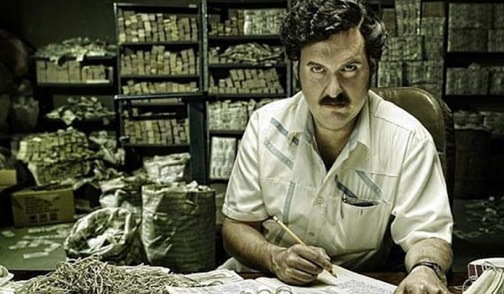
Premiering: Began streaming Friday, Aug. 28th on Netflix
Starring: Wagner Moura, Boyd Holbrook, Pedro Pascal, Juan Pablo Raba, Luis Guzman, Raul Mendez, Paulina Gaitan, Joanna Christie, Stephanie Sigman, Danielle Kennedy, Ana de la Reguera, Gabriela de la Garza
Produced by: Chris Brancato, Carlo Bernard, Doug Miro
By ED BARK
@unclebarkycom on Twitter
Colombia’s cocaine kingpin presided over a companion powder keg of murders, kidnappings, bribes and cartel wars.
Netflix’s Narcos is the latest to recount the life and very turbulent times of Pablo Escobar, whose thirst for violent reprisal claimed hundreds if not thousands of lives while he shrugged and told an underling, “Geniuses are always branded as crazy.”
Or at least that’s the way it goes down in Hour 8 of Narcos’ 10-episode first season. Typical of the docudrama genre, it’s based on a true story but with some scenes fictionalized for “dramatic purposes,” according to Netflix’s opening disclaimer. A few names are changed, too, during a depiction replete with narration from Drug Enforcement Administration agent Steve Murphy (Boyd Holbrook), who in real life also is Steve Murphy.
Episode 1’s sluggish start is due in large part to a long, flat narrative buildup. In due time, though, the exposition proves to be somewhat helpful (if not always well-written) in sorting out all the interlocking motivations, deals and double-dealings. Even so, an editor’s pencil would have been mightier than Murphy saying in Episode 3, “When you get too close to the sun, your dreams may melt away.” Still, it could have been worse. It could have been, “You get burned.”
The makers of Narcos otherwise have taken the bold and admirable step of letting Escobar and his fellow Colombians speak in their native Spanish tongue, accompanied by English subtitles. This requires extra vigilance on the part of non-Spanish speaking viewers while at the same time bolstering the drama’s authenticity.
Escobar is played by Wagner Moura, who brings swagger and presence to the role of a prosperous smuggler from a dirt poor background who hits the jackpot after meeting a cocaine manufacturer known as “Cockroach.” It’s Escobar’s idea to expand horizons and introduce the drug to the U.S. by all available means, including in small bags swallowed and carried by preferably pregnant women whom airport customs inspectors were likely to let pass.
“Imagine how much it would sell for in Miami,” Escobar says. He got that right -- to the tune of additional billions in revenues gained during the late 1970s and early 1980s. Escobar and his operatives literally didn’t know what to do with all of this cocaine-generated money. They buried some of it and also handed out cash to the poor during Escobar’s people-pleasing “Robin Hood” years.
But violence quickly became a byproduct, both in Miami and Colombia. In Murphy’s narrative view, the growing number of murders were inconsequential to the U.S. government. But all of that money pouring out of Miami got the attention of the Reagan administration. So it was time to set up the DEA in Colombia’s U.S. embassy, with agents, including Murphy, initially posing as janitorial employees. His new wife, Connie (Joanna Christie), joins him.
Narcos soon kicks in as a fascinating game of cat and mouse. Separating who’s on the take from who isn’t becomes a full-time obsession for both Murphy and his DEA partner, Javier Pena (Pedro Pascal), who regularly are hamstrung by protocol and other wrong-headed priorities. Escobar also has his hands full. Which government and military officials can be bribed and who simply needs to be bumped off? Which rival dealers can be relied on to do the “right” thing in return for the proper enticement?
The Medellin Cartel becomes a kingdom unto itself, with Escobar relying in times of emergency on his cousin and boyhood friend, Gustavo Gaviria (Juan Pablo Raba). Only he can get away with calling Escobar a series of pointed names to his face. Others are subject to severe reprisals, and Narcos doesn’t spare the rod in terms of the many violent acts triggered from all sides.
Escobar otherwise is a “family man” who’s kind to his only son and devoted to wife Tata (Paulina Gaitan) except when he’s being intimate with a beautiful sell-out TV journalist as a means of justifying his ends. In real life she was Virginia Vallejo, whose name has been changed to Valeria Valez.
The most familiar face to American audiences is Luis Guzman (Anger Management, How to Make It in America) as henchman/assassin Jose Rodriguez Gacha. Narcos also has at least one genuinely honorable politician in President Cesar Gaviria (a strong performance by Raul Mendez), who shows up in the second half of the series.
Narcos sets itself up for a second season with the open-ended denouement of its first. Netflix hasn’t yet officially committed to it, but a go-ahead seems very likely. Moura as Escobar doesn’t bring the overall manic and sometimes comic intensity of Al Pacino’s Tony Montana in Scarface. He’s never dull, though, giving Narcos a thoroughly sinister presence who’s capable of anything and will stop at nothing.
“He’s only comfortable at war. He’s taking us to the slaughter,” an underling murmurs out of earshot during a very strong Episode 5. That’s a precise and accurate reading of Escobar. But you know how those self-described “geniuses” can be.
GRADE: B+
Email comments or questions to: unclebarky@verizon.net
Breaking down the demographics of prime-time's hits and misses
08/28/15 10:07 AM
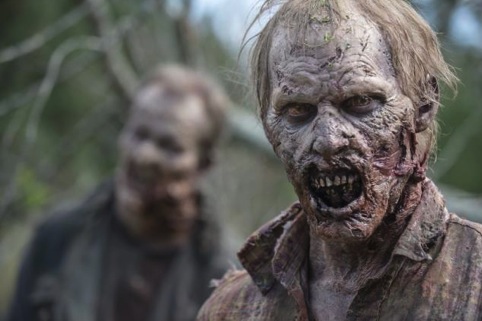
By ED BARK
TV’s coin of the realm, the advertiser-prized 18-to-49-year-old audience, continues to work against those shows that dare to “skew old.”
It’s not fair and never has been. But it’s pretty much the reality. Age-ism remains in full bloom when it comes to renewing or canceling series of all shapes, sizes, genres and colors. And I’d say that even if I weren’t well beyond this advertiser-prized demographic. Well, maybe I wouldn’t.
The age composition of the audience is less important if you’re HBO, Showtime, Starz, Netflix, Amazon Prime or other extra-fee-per-month “premium” or streaming networks. For them, your money’s good even if your teeth are in a cup and a zombie can out-run you. Here’s one notable example. Longmire, canceled by A&E because its audience was deemed to have too many liver spots, got picked up by Netflix and will start streaming all 10 Season 4 episodes on September 10th.
“Our viewers did skew older,” co-executive producer Greer Shephard said last month at the Television Critics Association press tour. “And A&E did not have an ownership stake in the show. We are, mercifully, now at a wonderful company that values viewers over demos.”
Those old enough to have experienced the 1960s first-hand shouldn’t get overly cranked up, though. Longmire is an aberration -- sort of like Betty White. The easiest path to renewal is still a solid percentage of 18-to-49-year-olds, even if your total viewership looks deficient on paper.
This brings us to the FX network’s always helpful statistical compilations, which it puts out on a non-partisan basis during every TV press tour. One of the latest is a ranking of all prime-time series that aired from Dec. 29, 2014 to May 17th of this year. Streaming sites are excluded because they still won’t provide any audience numbers for individual shows. And NBC’s Sunday Night Football, which would have been No. 2 among 18-to-49-year-olds, finished its regular season in December.
The kingpin of the 18-to-49 kingdom is AMC’s The Walking Dead, which has a median age of just 36 and ranked third in total viewers with 20.067 million in the Live + 7 Day Nielsen ratings. But here’s what scares the competition even more. An astonishing 13.228 million of those viewers were in the 18-to-49 motherlode.
Walking Dead also ranked No. 1 with 18-to-34-year-olds, averaging 6.775 million per episode.
Here are the other top 10 members of the 18-to-49 club.
2. Empire (Fox) -- 9.028 million
3. The Big Bang Theory (CBS) -- 8.011 million
4. Modern Family (ABC) -- 6.505 million
5. Game of Thrones (HBO) -- 6.160 million
6. How to Get Away with Murder (ABC) -- 5.880 million
7. Scandal (ABC) -- 5.378 million
8. The Voice (NBC) -- 4.944 million
9. The Voice (Tuesday) -- 4.892 million
10. The Blacklist (NBC) -- 4.819 million
Among these top performers, only Walking Dead, Empire and Game of Thrones drew more than half their total audience from the 18-to-49 age range. GOT was the biggest over-achiever, ranking just 42nd in total viewers.
Two animated Fox series, The Simpsons and Family Guy, also pole-vaulted into 18-to-49 prominence despite relatively low total viewer ranks. The Simpsons, which begin its gazillionth season this fall, ranked 50th in total viewers but No. 12 among 18-to-49-year-olds. Family Guy jumped from 88th to 38th place.
In the cable arena, AMC’s Talking Dead rated 65th in total viewers but 13th with 18-to-49-year-olds. FX’s American Horror Story: Freak Show soared from 74th to 18th place in those two ratings groups while AMC’s Better Call Saul was almost as impressive with a 72nd place finish in total viewers and a No. 19 ranking in the 18-to-49 demographic.
Both of the Fox cartoons and the three above cable series all drew more than half their audience from the 18-to-49 pool. Your renewal prospects are solid gold if you bat more than 50 percent in the 18-to-49 league.
Let’s look at a few opposite cases.
CBS’ Blue Bloods ranked 7th in total viewers with an average of 15.234 million per episode. But it skewed almost older than your neighborhood cemetery with just 2.659 million 18-to-49-year-olds. That put Blue Bloods in the 60th spot and also “on the bubble” regarding the year-end decision-making on whether to give it another season. The Tom Selleck cop show got a reprieve this time while low overall achievers such as ABC’s Marvel’s Agents of S.H.I.E.L.D. were considered shoo-ins for another season.
Blue Bloods averaged 8.242 million more total viewers than S.H.I.E.L.D., but trailed the ABC show among 18-to-49-year-olds by 695,000. In the rather twisted economics of network television, S.H.I.E.L.D. is considered the stronger property. Furthermore, Blue Bloods’ median age is 63 while S.H.I.E.L.D.’s is 47.
Why the premium on 18-to-49-year-olds and the discounting of older viewers? Whether or not it really makes sense anymore, younger viewers are still seen by Madison Avenue as more “impressionable” buyers of new and often crappy products while grandma and grandpa supposedly are set in their ways and wedded to many of the things they’ve been buying for years.
This is the argument even though relative oldsters tend to have far more disposable income than their younger descendants. Still, Jimmy Gamer can always ask his elders for enough money to buy a somersaulting cell phone and the latest Gargantuan Paul Bunyan Mega-Burger -- piled high with four all-beef patties, six slices of bacon, four melting cheeses, three onion rings, a fried egg, hash browns and cotton candy on a Frisbee-sized bun with baked-in M&Ms.
Let’s close by telling you why CBS’ CSI: Crime Scene Investigation got canceled and Fox’s Brooklyn Nine-Nine didn’t.
CSI, which will get a two-hour movie sendoff on Sept. 27th, still did quite well in the total viewer ratings, ranking 31st with an average of 11.108 million. Brooklyn Nine-Nine was 98th in this measurement with 4.407 million.
Among 18-to-49-year-olds, CSI ranked 61st with 2.629 million. Brooklyn Nine-Nine wasn’t all that much better with 2.751 million viewers and a 57th place finish.
But even though CSI drew 6.701 million more total viewers, its percentage of 18-to-49-year-olds stunk when compared to Brooklyn Nine-Nine’s. Remember that rule of 50 percent? Brooklyn Nine-Nine easily surpassed this threshold while CSI’s 18-to-49-year-old audience was less than 25 percent of its total.
In the end, that’s the overriding reason why one cop show gets a body bag and the other continues to patrol prime-time. From a critical standpoint and even though I’m an ancient mariner, I’m glad Brooklyn Nine-Nine survived. But 11.108 million viewers were still tuned to CSI every week. Problem is, they just weren’t the “right” ones.
Email comments or questions to: unclebarky@verizon.net
Broad, loud -- and funny: NBC's The Carmichael Show
08/26/15 09:22 AM
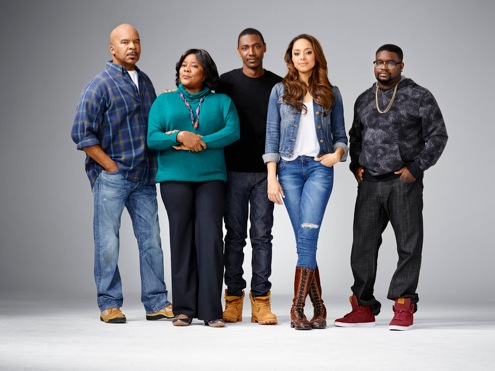
Premiering: Wednesday, Aug. 26th at 8 p.m. (central) with back-to-back episodes on NBC
Starring: Jerrod Carmichael, David Alan Grier, Loretta Devine, Amber Stevens West, Lil Rel Howery
Produced by: Jerrod Carmichael, Nicholas Stoller, Ravi Nandan
By ED BARK
@unclebarkycom on Twitter
Loud is loud, and The Carmichael Show certainly is that.
Funny is funny, too. And here’s a fractious family sitcom with lots going for it as a throwback to the likes of Sanford and Son, The Jeffersons and Good Times.
Not much was expected going in. NBC seemingly is burning off The Carmichael Show -- as it did with Mr. Robinson -- by airing back-to-back episodes for three consecutive Wednesdays before the so-called “regular season” kicks in. Both comedies are propelled by black male stars. But Mr. Robinson landed its jokes with a series of big thuds while The Carmichael Family is much smoother, even in the face of decibel levels that threaten to shatter the sound barrier whenever Momma and Daddy are spouting their decidedly old-school values.
The show’s quieter presence is North Carolina-bred comedian Jerrod Carmichael as Jerrod Carmichael. His “therapist in training” girlfriend, Maxine (a well-tuned Amber Stevens West), has recently moved in with him. But Jerrod very much wants to keep this a secret from his parents, Joe and Cynthia (David Alan Grier, Loretta Devine). That’s because he knows they’ll go all crazy on him. Not that they wouldn’t anyway.
Dad, a truck driver and triple bypass survivor, is first seen eating ribs with nacho cheese dipping sauce while wearing a “Neo-Bama” t shirt. His wife, a devout Bible believer, is also Joe’s enabler. Her cooking could clog the Hoover Dam and she still preaches the virtues of Paula Deen’s biscuits (in the third of three episodes sent for review).
An even-tempered but opinionated son beset by rigid parents is an eternal sitcom trope. But if the trope fits . . . Somehow it does with The Carmichael Show, which can be laugh-out-loud funny because its cast knows just what to do with some pretty sharp material.
Momma’s favorite diss is “nasty.” As in, “Votin’ Republican and livin’ in sin. Just nasty!”
But Joe says he once voted for George W. Bush because his administration sent him a $1,600 stimulus check. No, his vote can’t be bought. But yes, “it can be stimulated.” Grier knows how to deliver such lines after a long career in TV comedy that first took hold with In Living Color. Devine’s a seasoned pro, too, selling her shrill bursts with complete conviction.
There’s also a less than cerebral older brother named Bobby (Lil Rel Howery), who hasn’t yet told his parents he’s divorced. Jerrod uses this information as last-ditch leverage in hope’s of thwarting Maxine’s insistence that they come clean with Joe and Cynthia. In Wednesday’s first episode, it all plays out without ever petering out.
Episode 2 is built around protests in Charlotte over a police shooting of an unarmed young black man. It also happens to be Jerrod’s birthday. Maxine, wearing a “Black Lives Matter” t shirt, finds a surprisingly willing protest partner in Cynthia while Jerrod just wants to enjoy his birthday in peace and Joe is matter-of-factly indifferent.
“Do you always get this giddy when somebody gets shot?” he asks. But Cynthia has marched many times before and is eager to get back in that groove. “I can hear the bells of justice ringin’ and I’m answering the call,” she proclaims before heading upstairs to change into her “civil rights clothes.”
The pros and cons keep piling up, with Jerrod caught in the middle. It’s a fairly daring, message-sending episode, with perhaps something to offend just about everyone. A certain other comedy series with a Bunker mentality used to do much the same. And they were loud about it, too.
Episode 3 is more conventionally built around Joe’s continued artery issues and Cynthia’s refusal to alter his diet. She gets the best line after Jerrod foists kale on them during a family dinner at which Maxine strives to be better-liked by stifling her heart-healthy cooking. “It was just nasty,” Momma says. “Felt like Christmas tree in my mouth.”
The Carmichael Show won’t win any prizes for originality. It does, however, play very well with the above-average material it has. That’s in no small part due to the well-blended cast. Jerrod Carmichael seems comfy in the sitcom realm as a lower-keyed son with occasional flareups. Amber Stevens West is instantly appealing in a reactive/assertive role while David Alan Grier and Loretta Devine turn up the heat without scalding everything.
It all makes for a pleasant surprise in one of television’s longstanding nowhere lands between the end of summer and the start of all that fall season “excitement.” In that context, NBC is tossing on a show that really shouldn’t be tossed out after its six episodes quickly come and go.
GRADE: B
Email comments or questions to: unclebarky@verizon.net
Public Morals gives TNT a sharply defined period cop drama
08/25/15 08:29 AM
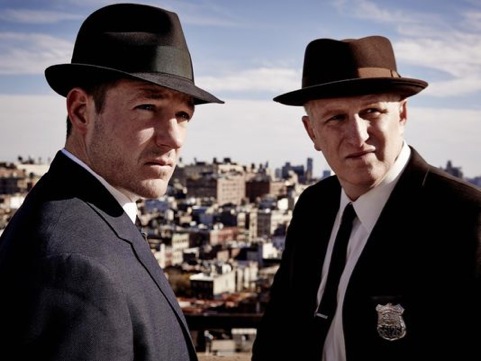
Premiering: Tuesday, Aug. 25th at 9 p.m. (central) on TNT
Starring: Edward Burns, Michael Rapaport, Elizabeth Masucci, Katrina Bowden, Ruben Santiago-Hudson, Austin Stowell, Wass Stevens, Brian Wiles, Neal McDonough, Brian Dennehy, Robert Knepper, Kevin Corrigan, Aaron Dean Eisenberg, Keith Nobbs, Patrick Murney, Lyndon Smith, Cormac Cullinane
Produced by: Edward Burns, Steven Spielberg, Justin Falvey, Darryl Frank, Aaron Lubin
By ED BARK
@unclebarkycom on Twitter
Everybody cracks wise in Public Morals, a crisp and lively new TNT series that might actually generate a little buzz for the oft-overlooked “We Know Drama” network.
Set in 1960s New York and also set initially to The Doors’ version of “Back Door Man,” it mixes tough-talking vice cops on the take with turf-protecting crime bosses and their not always subservient underlings. Short tempers abound, as do swaggering, sharp-dressing and women who know what they want. “Bullshit” is the operative denunciation, and it’s used with impunity in the four episodes made available for review.
Actor Edward Burns created the series and also stars in it as plainclothes officer Terry Muldoon. He has a sharply drawn wife, Christine (well-played by Elizabeth Masucci), and a simpatico partner named Charlie Bullman (Michael Rapaport again in solid form after a bravura guest shot in this season’s Louie).
Muldoon, Bullman and their hats patrol the boiling Hell’s Kitchen neighborhood, where prostitution, gambling and other illicit vices are managed rather than quashed. Protection payments are expected in return. Otherwise you’re goin’ downtown.
Burns, whose character also is the father of three children, gives himself plenty to do in Tuesday’s premiere hour. He rasps his way through meaty chunks of verbiage, laying down the law on both the streets and the home front, where trouble-prone 13-year-old son James (Cormac Cullinane) is on the receiving end of some very blunt tough love.
“Try a softer touch with him,” his wife advises.
“The line between the good guys and the bad guys is very thin,” he retorts after repeatedly deriding his oldest son for being both an “asshole” and a “moron.” But the kid seems to be getting the message, and willingly leads the family in grace before a family dinner in Episode 2.
Public Morals otherwise is teeming with supporting players, none more vivid than the redoubtable Brian Dennehy as Irish crime patriarch Joe Patton. Dennehy doesn’t pop in until Episode 2. But boy, does he pop, particularly when belittling his trigger-happy son, Rusty (Neal McDonough). There’s another terrific scene in Episode 3, with old Joe telling a shaky subordinate mobster known as “Smitty” (fine work by Kevin Corrigan) how it’s gonna go down in the aftermath of a lethal hit at the end of Episode 1.
Three of the first four hours end with murders. But the violence isn’t of the blood-spurting type -- not yet anyway. One of Burns’ co-producers is Steven Spielberg, who’s never been big on buckets of blood. The beatings also are quick and efficient.
Interestingly, Public Morals shares the same name as an instantly canceled 1996 comedy series about the NYPD vice squad. Produced by Steven Bochco (Hill Street Blues, NYPD Blue and TNT’s current Murder in the First), it was widely derided before its premiere for a coarse approach that included use of the term “pussy posse.” Bochco reluctantly excised those words from the on-air first episode, but CBS decided to make it one and done for Public Morals. Those who missed the show on the night of Oct. 30, 1996 were fated to never see it at all.
Peter Gerety, who co-starred in the original Public Morals, has a recurring role in the far superior TNT version as Muldoon’s acerbic father. And yes, the term “pussy posse” is used in Episode 2. There’ll be no uproar this time.
Public Morals has many characters to service. And by the end of the first four of 10 Season 1 episodes, viewers have been given a fair chance to get a handle on most of them.
Robert Knepper, best known as the sadist from Prison Break, registers as the hard-bitten Capt. Johanson while rookie Jimmy Shea (Brian Wiles) is quickly introduced to a world of cops who know that much of their bread is buttered with kickbacks.
Sean O’Bannon (Austin Stowell) is the volatile young cop son of a brutal, drunken mobster while plainclothes vice officer Vince Latucci (Wass Stevens) is a sharp-dressed man with an even sharper-tongued wife. Deirdre Duffy (Lyndon Smith), sister of a two-bit hood fresh out of jail, takes a strong liking to Sean’s manly looks and ways while a schoolteacher/prostitute named Fortune (Katrina Bowden) draws closer to Muldoon’s partner, Charlie.
Burns, the overall architect, convincingly acts his part while also bringing a sense of order to all of these proceedings. New TNT programming head Kevin Reilly has said he’s re-positioning TNT as an edgier network with more challenging fare. The second coming of Public Morals, in an altogether different form, looks to be a strong step in that direction. It clicks, crackles and arrests attention with a blend of compromised cops, assorted criminals and homier family values.
GRADE: B+
Email comments or questions to: unclebarky@verizon.net
Fear the Walking Dead makes it a twosome on AMC
08/21/15 01:38 PM
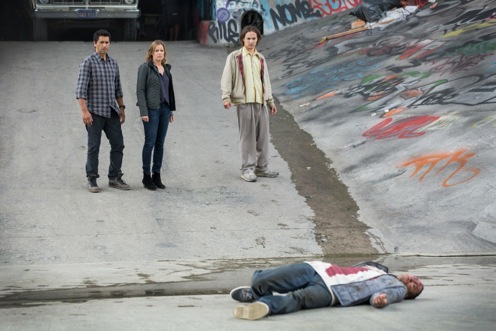
Premiering: Sunday, August 23rd at 8 p.m. (central) on AMC
Starring: Cliff Curtis, Kim Dickens, Frank Dillane, Alycia Debnam-Carey, Lorenzo James Henrie, Elizabeth Rodriguez, Ruben Blades, Mercedes Mason, Patricia Reyes Spindola,
Produced by: Robert Kirkman, Gale Anne Hurd, Dave Erickson, Greg Nicotero, David Alpert
By ED BARK
@unclebarkycom on Twitter
The possibilities are staggering, and not just from a zombie standpoint.
AMC’s The Walking Dead still reigns as the runaway winner in ratings among advertiser-prized 18-to-49-year-olds, with 13.2 million of its 20.1 viewers in that age range. The distant No. 2 prime-time scripted series, Fox’s Empire, had a Season 1 average of 9 million viewers in this key demographic, according to Live +7 (days after) ratings from Nielsen Media Research.
In that respect, AMC’s new Fear the Walking Dead prequel might just as well be called Milking The Walking Dead For All It’s Worth. Premiering on Sunday, Aug. 23rd with a 90-minute episode, it’ll be a hit if it draws even half of the original’s 18-to-49-year-old crowd. That would match this season’s haul for HBO’s Game of Thrones.
Season 1 of Fear will be just six episodes, with Season 2 ramping way up to 15. The producers say they’re aiming for a “slow burn” this time out, with up-close looks at uninfected characters initially taking precedence over the mutants beginning to terrorize East L.A. OK, fine. But it’s easy to envision the original’s rabid fans getting restless and thirsting for quick gratification in the form of multiple exploding zombie heads and attendant violent acts. I mean, let’s get real here. This is not an audience that likely would sit still for even five minutes of Downton Abbey.
Episode 1 of Fear begins in an abandoned church where something bad has happened. Drug-addicted misfit Nick Clark (Frank Dillane) rouses to this occasion after sleeping off his latest stupor. The young woman he’s been with has suddenly turned into a hideous something else. Fleeing the premises in a hurry, Nick is hit by a car and taken to a hospital in police custody. Why? Because he appeared to be on the run from a foul deed or something.
It turns out Nick is the son of high school guidance counselor Madison Clark (Kim Dickens), a single mother whose fiancee is divorced English teacher Travis Manawa (Cliff Curtis). He also has a problematic, resentful son (Lorenzo James Henrie as Chris) while Madison’s daughter, Alicia (Alycia Debnam-Carey), is a high-achiever who’s fed up with her brother.
So there’s a lot of angst here for starters. But beyond that, one question keeps rising above all of this. Let’s briefly set the stage.
Nick insistently tells Travis, “I was running away from what I saw,” and not hallucinating again. “If that came out of me, I’m insane . . . I really don’t want to be insane.”
Travis then visits the church to check out Nick’s story. He sees some very bloody remains, but DOES NOT CALL THE COPS to investigate further and hopefully clear Nick’s name. Instead he tells Madison, “There was a lot of blood.” But she blithely replies that “bad things happen.”
Travis and Madison then visit the church together so she can see for herself. Madison agrees that “something bad happened here.” But THEY DO NOT CALL THE COPS. Meanwhile, shackled Nick has rather unconvincingly escaped from the hospital in hopes of clearing his head and finding out if his girlfriend in fact was eating people alive at that church where bad things indeed happened but NO ONE CALLED THE COPS.
Maybe I’m expecting too much elementary logic 101 from a series about an impending zombie apocalypse. Still, this kept eating at me, so to speak.
Fear eventually gets around to a traffic jam caused by a staggering zombie and another bad thing happening to Nick. At the end of the premiere episode -- and this really isn’t giving away anything -- we get a two-pronged WTF from Travis and Madison.
“What the hell is happening?” she asks.
“I have no idea,” he replies.
The producers of Fear say they won’t be catching up to the first days of The Walking Dead anytime soon. Nor will they be explaining how the zombies originated before they began to rapidly multiply.
So good luck with all that. Fear the Walking Dead probably is in no danger of becoming an out-and-out flop in its first season. But its opening episode is appreciably less gripping than the 2010 unveiling of the smash hit original. There’s also the growing possibility that zombie and even shark fatigue might finally be settling in as the world perhaps moves on to -- oh, I don’t know -- pesticide-crazed giant killer potatoes from Idaho.
GRADE: C
Email comments or questions to: unclebarky@verizon.net
Starz's Blunt Talk does some funny business for Patrick Stewart
08/21/15 09:31 AM
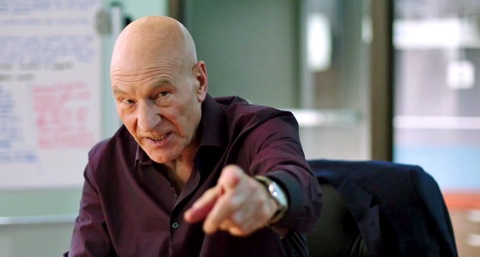
Premiering: Saturday, Aug. 22nd at 8 p.m. (central) on Starz
Starring: Patrick Stewart, Adrian Scarborough, Timm Sharp, Dolly Wells, Jacki Weaver, Mary Holland, Karan Soni, Richard Lewis, Ed Begley Jr., Romany Malco
Produced by: Jonathan Ames, Seth MacFarlane, Stephanie Davis, Tristram Shapeero, Duncan Birmingham, Reed Agnew, Eli Jorne
By ED BARK
@unclebarkycom on Twitter
Brittle Brit Walter Blunt is bombastic, needy, oft-besotted, four times divorced and newly dedicated to reinventing himself for the greater glory of the American people. But this is only after an embarrassing incident further jeopardizes his already low-rated cable news network show.
The network just happens to be UBS. And the link to the classic 1976 film Network is fully intentional. Blunt Talk’s creator, Jonathan Ames, acknowledges without hesitation that his star player is “very much” meant to be an extension of Howard Beale, whose “Mad as Hell” clarion call is still echoing.
“In preparation for writing this, I re-watched Network,” Ames recently told TV critics. “And I thought, ‘Wait, I want more Howard Beale . . . Let’s get behind the scenes with Howard Beale.’ “
The millions who have seen the movie know what happened to Beale in the end. So Blunt is a resurrection in this half-hour darkly comic series that’s already been renewed for Season 2.
Four episodes were sent for review, and there’s more than enough here to make Blunt Talk worth a continued investment. It hasn’t quite found itself yet. But each of these early episodes has an inspired high point or two, whether it’s Blunt interviewing himself; being conquered by automated airport bathroom devices; getting towel-whipped as penance by his faithful manservant; faking a report from hurricane-threatened Galveston; or debating whether to affect his Bono or Peter Jennings look before heading off to an Alcoholics Anonymous meeting.
Stewart, who came to prominence on these shores as stern Capt. Jean-Luc Picard in Star Trek: The Next Generation, adapts nicely to this considerable change of pace. He’s aided by a solid supporting cast, most notably Adrian Scarborough as the loyal Harry, whose activities range from reading Blunt bedtime stories to posing for a nude portrait that figures heavily into the plot of Episode 2. The two of them have been inseparable since serving together in the military.
Blunt is first seen on his own, getting drunk and making his own form of grandiose small talk with a bartender before heading out unsteadily into the night. A few marijuana chocolates and a transsexual later, Blunt finds himself impulsively kicking a cop in the testicles and then shouting from the hood of his Jaguar while it’s all captured on video by a “ZMT” crew.
It’s the hottest water he’s ever been in, but Blunt is nothing if not resilient -- and deluded. He rallies his staff and concocts a plan of action and reaction. Rosalie (Jacki Weaver), his veteran producer and manager, offers to soothingly spoon with Blunt on an inflatable mattress before he’s delivered unto a UBS psychiatrist played by, of all people, Richard Lewis.
Blunt confesses that he fears the same fate as disgraced Penn State football coach Joe Paterno, who was dismissed and soon died. But on what could be his last show, he declares to one and all, “I am no lion in his winter! I am an eagle in the spring! Yes, a bald eagle if you like.”
Well, it all somehow works. Otherwise Blunt Talk would be over, out and done with Blunt’s TV tagline, “Right here. Right now.” Which wouldn’t make for much of a show.
In subsequent episodes he’s newly determined to “be a better father to the American people -- and of course to my own children.” Furthermore, “From now on I want to be in the hope business.”
That’s pretty much Beale talk. But Blunt’s careening misadventures take him to the next level. Episode 2 finds him resorting to a porn film director who demands something in return for faking Blunt’s live shot from Galveston. The sight of Stewart in a yellow UBS rain slicker and matching brimmed hat is alone worth the price of admission to this one.
Episode 3, the strongest so far, also works in the romantic entanglements of Blunt’s staffers, with Ed Begley Jr. popping in to play Jacki’s “open marriage” husband, Teddy.
The fourth half-hour is built around Blunt’s efforts to in fact be a better father to his five-year-old son. There’s also a closer look at the bonds that bind Blunt and manservant Harry. Singer-songwriter Moby, who wrote the theme music for Blunt Talk, plays himself to good effect in this one. Also look for a brief appearance by the late Windell Middlebrooks, a Fort Worth native who became best known as the no-nonsense deliveryman in a series of Miller High Life commercials. The episode is dedicated to him.
Blunt Talk’s overall absurdity at times over-reaches and grabs viewers too hard by the throat. Still, its excesses are offset by enough inspired lunacy to carry the day. I’m still grinning at Blunt’s grapplings in that airport restroom. They’re positively Kramer-esque, with apologies to Howard Beale.
GRADE: B+
Email comments or questions to: unclebarky@verizon.net
Sooner or later it had to happen: Lifetime's The Unauthorized Full House Story
08/20/15 11:30 AM
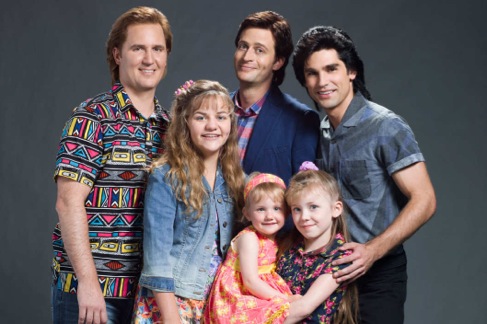
By ED BARK
@unclebarkycom on Twitter
Don’t let anyone tell you otherwise. Being a critic-proof success always trumps being an acclaimed flop.
ABC’s Full House went completely Emmy-less while its cast became rich and famous. And now here comes Lifetime’s suitably innocuous The Unauthorized Full House Story. It premieres on Saturday, Aug. 22nd at 7 p.m. (central) as the filler before Netflix’s upcoming Fuller House reboot, which will reunite all of the original cast members except the opting out Olsen twins.
Premiering in 1987 and running for eight seasons and 192 episodes on ABC, Full House virtually birthed Mary-Kate and Ashley Olsen while also providing very gainful employment for Bob Saget, John Stamos, David Coulier and assorted co-stars.
Saget’s the driving force of the Lifetime movie. Played fairly capably by Garrett Brawith, he’s initially a sardonic standup comic who works blue, considers himself an artiste and compromises himself only after learning that his wife, Sherri (Juliana Wimbles), is pregnant with their first child.
After getting fired for ad libbing too much on another failed CBS morning show, Saget is encouraged to give Full House a shot.
“It’s about a dad with a dead wife raising three little girls,” he tells Sherri of the pivotal Danny Tanner role. “See, you cannot stop laughing.”
But he yields after the actor originally cast as Danny is seen as good but not great by Full House creator Jeff Franklin (Matthew Kevin Anderson). This leads to Saget’s best line after the show is shredded by critics, with even People magazine giving it a D+.
“That’s my show,” he commiserates with Sherri. “A hot, steaming slice of yummy crap pie.” Delicious.
A pre-Full House Stamos (Justin Gaston) is first seen shlepping at his dad’s diner after quitting General Hospital and enduring two failed prime-time series (for the record they were “Dreams and You Again?). “Fewer parties, more work,” the old man counsels his heartthrob kid, who considers himself to be “damaged goods.”
Coulier (Justin Mader) is excited about joining the cast of Saturday Night Live until he’s crushed by the show’s decision to dump him before he starts. Not only that, he has a flatulence problem that’s revisited throughout the movie.
So yes, they end up forming an unlikely Full House trio, with Saget constantly carping and threatening to quit in the early going while Stamos and Coulier urge him to stay for the sake of all their careers.
“I didn’t get into comedy to be popular,” Saget moans. “I wanted to be relevant . . . Every line out of my mouth makes me want to hurl.”
But of course he stuck it out, getting the host job on America’s Funniest Home Videos in the bargain while Stamos played the field and Coulier kept farting before, during and after a failed marriage.
“Dude, you’ve been on more hot women than sun block,” Saget tells Stamos just before he begins dating Paula Abdul for a minute or so.
The revelry and ribaldry eventually give away to an abundance of sappiness, much of it involving Stamos. But Saget first gets a last hurrah by messing around with a mannequin on the Full House set after envisioning himself as host of “America’s Favorite Sexual Positions.” His impressionable young co-stars see some of this, prompting producer Franklin to blow up and order Saget to “get it together.” Alas, he then pretty much does.
Meanwhile, Stamos yearns to find the right woman and be seen as more than an “airhead” sitcom star. Back at the diner, his pop tries to set him straight in a scene that might have been rejected as too corny and cloying even for Full House. “If you want something more, you have to grow up,” he’s told. ”No agent is going to help you with that.”
Down the stretch, Stamos becomes a fatherly mentor to the easily hurt Candace Cameron (Shelby Armstrong/Brittney Wilson), who played Donna Jo “D.J.” Tanner throughout the show’s run. Everyone ends up heartbroken when ABC finally cancels Full House, with Saget getting full-circle squishy during a cast reunion two years later at Candace’s wedding.
A few nice turns by Brawith as Saget aren’t enough to make The Unauthorized Full House Movie more than a connect-the-dots, dish-a-little-dirt, spoon-a-little-sugar, cut-print diversion. Still, it’s nowhere near a desecration, giving fans of the series a basically harmless glimpse at how the thing came together and somehow stayed together. A-w-w-w-wesome. Now on to Fuller House.
GRADE: C
Email comments or questions to: unclebarky@verizon.net
IFC's Documentary Now! turns the genre upside down
08/19/15 02:56 PM
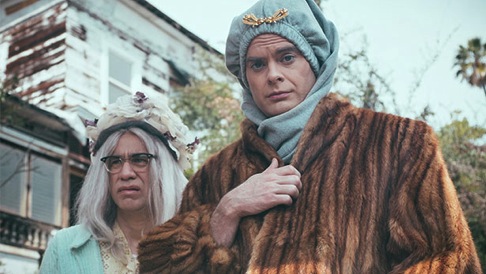
Premiering: Thursday, Aug. 20th at 9 p.m. (central) on IFC
Starring: Bill Hader, Fred Armisen
Produced by: Seth Meyers, Bill Hader, Fred Armisen, Lorne Michaels, Rhys Thomas, Andrew Singer
By ED BARK
@unclebarkycom on Twitter
Initially showing Bill Hader and Fred Armisen in drag perhaps proved to be an irresistible promotional opportunity.
So that’s the way IFC’s Documentary Now! kicks off, with an intermittently amusing send up of Grey Gardens titled “Sandy Passage.”
The better news: Two subsequent half-hour episodes available for review are incrementally funnier than the first one, with “Kunuk Uncovered” a fully realized howl drawn from 1922’s Nanook of the North and featuring a guest appearance by John Slattery.
Hader and Armisen are the on-camera principals, with main writer Seth Meyers unseen so far -- or so far as I can tell. Helen Mirren serves as host, lending a mostly straight-ahead gravitas to what’s supposed to be the 50th distinguished year of Documentary Now!
Season 1 has six episodes, with skewed looks at The Thin Blue Line and History of the Eagles (a two-parter) coming later. Episode 5, “A Town, A Gangster, A Festival,” is Armisen’s completely made up salute to Arborg, Iceland and its annual Al Capone festivities. A grateful IFC already has ordered two more seasons, further underscoring the joys of working for a still smallish cable network.
The “Sandy Passage” opener revisits the 1975 documentary by brothers Albert and David Maysles. They trained their cinema verite cameras on reclusive Big and Little Edie Beale, an upper class mother and daughter who had holed up in their badly decaying East Hampton, NY Grey Gardens estate.
For the purposes of Documentary Now!, Hader does most of the talking as 56-year-old “Little Vivvy” Van Klimpton while Armisen spends a lot of time in bed as the tart, 75-year-old “Big Vivvy.”
They otherwise live with two cats and a raccoon, with filmmakers Larry and Alfred Fein becoming increasingly bored and then scared. It’s fun watching Hader in various headdresses while Armisen remains very adept at looking haggard. Little Vivvy showing off her dancing skills (while waving a miniature American flag) and Big Vivvy groaning out “Pitter Patter” also are grin-worthy. But this particular mockumentary peters out before its forced conclusion.
The Aug. 27th episode, a lampooning of HBO’s Vice investigative documentary series, is subtitled “Dronez: The Hunt for El Chingon.” Jack Black guests as Jamison Friend, who presides from command central while correspondents seek to locate and interview Ciudad Juarez’s reigning drug kingpin.
Let’s just say that bad things to Dronez investigators John Sachs and Kyle Riley, and then to Trevor Kenney and Bryce Bowen. But an A-team of Lars Klegg and Denver McGiver is fated to make a little progress. All of the roles are played by Hader and Armisen, who probably are having more fun than the law should allow. The overall solemnity cloaking these proceedings is palpably funny, with Black doing a solid as the out-of-harm’s-way orchestrator.
Then comes “Kunuk Uncovered” (Sept. 3rd), a parody of the 1922 black-and-white silent film by Robert J. Flaherty. In the mashup, guest star Slattery plays director William H. Sebastian and Armisen is the inept but increasingly demanding eskimo Kunuk (real name “Pipilok”).
Armisen is fall-down funny here, whether he’s merely falling down or happily grinning and waving at the camera. Among the “current-day” interviewees is Marie Claudette, ID’d in print as ”former Eskimo whore” for the purposes of her reminiscences.
It helps to have at least a passing familiarity with the documentary films being spoofed. But very few have seen the ancient Nanook of the North, and in this case it really matters not. “Kunuk Uncovered,” which -- no joke -- was filmed in Iceland, is easily goofy enough to stand completely on its own.
Hader, Armisen and Meyers, old mates from Saturday Night Live, will have ample fertile territory for future seasons. Pick any Michael Moore documentary and get crazy with it. Throw The Jinx into the mix. Let ‘er rip with 20 Feet From Stardom or one of Frederick Wiseman’s “observational” treatises on hospitals, high schools, boxing gyms, etc.
Not everything lands squarely on target in the first three half-hours of Documentary Now!. But there are enough moments -- and quite a lot of them in Episode 3 -- to keep this ambitious enterprise on track and well worth a roll ‘em.
GRADE: B
Email comments or questions to: unclebarky@verizon.net
CNN's Evocateur recaptures Morton Downey Jr. at the height of his glowers
08/19/15 09:43 AM
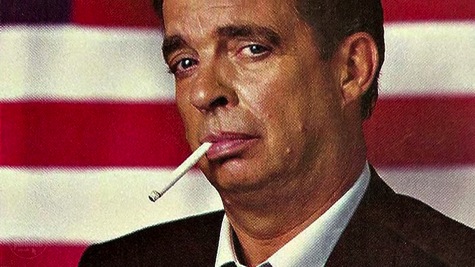
By ED BARK
@unclebarkycom on Twitter
A then rotund Al Sharpton Jr. got knocked off his chair by Congress of Racial Equality chairman Roy Innis and in another instance aimed a homophobic epithet at an audience member that today would get him knocked off MSNBC for at least a short while.
Presidential candidate Ron Paul, then running on the Libertarian ticket, endured a very up-close encounter with a host who bellowed, “If I had a slime like you in the White House, I’d puke on you!” Another regular guest, the still very prevalent Gloria Allred, responded to a verbal jab at her breasts by downsizing the host’s penis.
In the documentary Evocateur: The Morton Downey Jr. Movie (Thursday, Aug. 20th from 8 to 10 p.m. central on CNN), one can still smell the toxic fumes coming off the old TV brow-beater and his ever-present cigarettes, which he used to autograph for admirers.
Directors Seth Kramer, Daniel A. Miller and Jeremy Newberger mix fresh and earlier interviews, archival footage and some really great animation to recapture a coarse, insecure, womanizing ringmaster who burned white-hot, flamed out fast and in some ways paved the way for all sorts of latter-day televised freak shows. There’s no revisionist lionizing here, but plenty of perspective.
Downey Jr., son of a famous same-named singer, entertained the teeming masses with a show that had his mostly young studio audience verbally up in arms and salivating at the sight of their lion devouring the latest liberal put before him. His money shot was “pablum pukers.” Oh how the crowd roared.
After a while the “respectable” guests stopped coming, leaving the host to riff off a steady parade of strippers and so-called deviants. “Sit down, you fat bitch!” he brayed at a beyond voluptuous woman while thrusting his pelvis against her.
He didn’t have much staying power. The Morton Downey Jr. Show premiered in 1987 on the Secaucus, NJ-based WWOR-TV before going into national syndication the following year. But in July, 1989 the show was canceled shortly after Downey told a highly suspicious tale about being beaten in a San Francisco International Airport restroom by three “skinheads” who also snipped his hair, ripped his shirt and drew Swastika marks on his face.
Downey emerged with the “evidence” intact. But after years of helping to fabricate and then legitimize the incident, his longtime friend, Lloyd Schoonmaker, comes forward in Evocateur to say he was with Downey at a convenience store when they bought a pair of scissors and a felt marking pen.
“I hate myself for doing it in hindsight,” Schoonmaker says of his complicity. “But I did it . . . I’m not lyin’ now.” Schoonmaker still has the damaged shirt Downey wore at the time, and jokes that he might sell it on eBay someday.
Downey’s Dr. Frankenstein was MTV founder Bob Pittman, who tells the filmmakers he wanted to find a successor to Joe Pyne, another highly argumentative conservative who came to prominence in the 1960s. Pittman got his man after watching Downey trade insults with Wally George, a Southern California-based right-winger who once proudly billed himself as the “Father of Combat TV.”
“It’s dependent on finding ’The Person,’ “ Pittman says. “Mort just understood performance.”
He soon rocketed into prominence, using some of the same techniques George had deployed. Guests were regularly thrown off The Morton Downey Jr. Show, to the delight of a crazed mob -- er, disaffected citizens -- filling his small TV studio. Comedian Chris Elliott says he became “immediately mesmerized” by Downey but couldn’t figure out how much of his show was a complete put-on. Elliott also is shown lampooning Downey on NBC’s Late Night with David Letterman.
Pat Buchanan, also newly interviewed for Evocateur, contends that “my old friend Mort” served as a voice for fed-up Americans who felt disenfranchised in the late 1980s (even though Ronald Reagan was still President). Naming Bill O’Reilly, Sean Hannity and Glen Beck as Downey descendants, Buchanan says, “They aren’t as crude as Mort was, but they are appealing to the same audience.”
From this perspective, though, TV critic David Bianculli comes far closer to the real truth in an old interview snippet from those times. Downey “is in the business of implicitly selling us hatred. And people are buying it,” he says.
His interviewer then asks, ”Is there something in the nature of television that calls forth characters like this periodically?”
“Uh, yeah. Ratings,” says Bianculli, who remains in play to this day as the founder of tvworthwatching.com and author of the 2009 book Dangerously Funny: The Uncensored Story of The Smothers Brothers Comedy Hour.
Downey later had an epiphany of sorts, but only after learning he was dying of cancer. He recanted his flaunting of cigarette smoking and appeared on several editions of Larry King Live in connection with his battle to stay alive.
“I got the most beautiful letter from Edward Moore Kennedy,” he told King, referring to his past public support of the liberal Massachusetts senator before he steered hard right with a vengeance. He went by his birth name of Sean Morton Downey back then.
Downey’s old TV show producers and his daughter, Kelli Downey Cornwell, also are interviewed for Evocateur. Her reminiscences seem mostly sad-eyed. As a teenager she watched her father openly cheat on his wife and her mother. That was at the height of his fame and fortune, when Downey strode into his TV studio arena with mouth and cigarette blazing. In each case, he was probably just blowing smoke. And for a short while, many inhaled.
He died on March 12, 2001 at the age of 68. His funeral had a surprisingly low turnout, as shown in Evocateur. But old pal Lloyd Schoonmaker was there, singing “I Can See Clearly Now” while blue balloons floated upward.
Morton Downey Jr. certainly didn’t elevate the level of discourse during his brief time on top of the world. But as Pittman notes, “Often the self-destructive people are really entertaining.”
As well as disgusting, debasing and divisive. But in this case, thankfully not for long.
GRADE: B+
Email comments or questions to: unclebarky@verizon.net
HBO and David Simon re-team in exemplary Show Me a Hero
08/16/15 10:39 AM
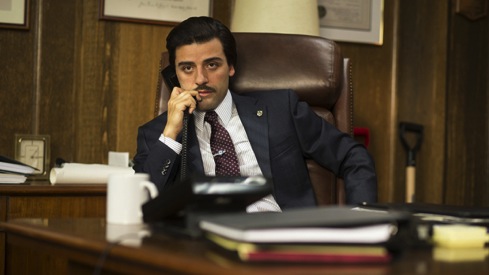
Oscar Isaac stars as “boy mayor” Nick Wasicsko in Show Me a Hero. HBO photo
Premiering: Sunday, Aug. 16th at 7 p.m. (central) on HBO with back-to-back-hours. Continuing at the same times on Aug. 23rd and 30th.
Starring: Oscar Isaac, Carla Quevedo, Alfred Molina, Winona Ryder, Ifenesh Hadera, Jim Belushi, Catherine Keener, LaTanya Richardson-Jackson, Clarke Peters, Peter Riegert, Natalie Paul, Brianna Horne, Bob Balaban, Terry Kinney
Produced by: David Simon, Paul Haggis, Nina K. Noble, Gail Mutrux, William F. Zorzi
By ED BARK
Only David Simon would dare to attempt -- let alone pull off -- a six-hour scripted miniseries on the racially polarized walkup to a 200-unit low income housing project.
His landing spot again is HBO, which has presented Simon’s The Wire, The Corner and most recently, Treme. All were critically acclaimed inner city dramas with smallish viewing audiences. Show Me a Hero, premiering on Sunday, August 17th and continuing on the following two Sundays, likely will end up being the same story. Favorable critical reviews, low audience turnout.
It seems like a lot to ask during the waning days of another long, hot summer. Settle in for two hours on three Sunday nights for the true story of how a federally ordered mandate to nominally integrate a white Yonkers, NY neighborhood set off a powder keg of resentments and racism cloaked with the protection of property values. Caught in the middle was former cop turned city councilman Nick Wasicsko (Oscar Isaac), who in 1988 unseated six-term incumbent Angelo Martinelli (Jim Belushi) to become the youngest mayor in America at age 28.
Wasicsko was strictly an opportunist at first, running on a campaign to appeal the federal court order before those hopes were almost immediately dashed. He then got caught in the middle, presiding over a series of stormy City Council meetings in which his backing of the court order to avert heavy fines for non-compliance made him both a traitor and an easy political target.
Simon and co-executive producer/director Paul Haggis (Million Dollar Baby, Crash) skillfully blend nuts and bolts with the very human, intertwining stories of politicians, disadvantaged minority women and a middle-aged white Yonkers resident with a steely resolve to stop the housing project in its tracks. The story is adapted from Lisa Belkin’s same-named 1999 book, for which Simon has written a Foreword for a new paperback edition. Its title comes from an F. Scott Fitzgerald quote: “Show me a hero, and I will write you a tragedy.”
Simon’s central point in taking on this challenging re-telling can be found in the conclusion to his Foreword: “Over these wasted decades,” he writes, “we have become a people ever better at politics, but less and less capable of governing ourselves. To this present day, we still think it needs to be about us, and never about them, as if making such distinctions aren’t always the foundational cracks in the national edifice. Incredibly, the battle for Yonkers in 1987 is still the same argument, ongoing, today.”
That sounds preachy on the face of it. But Show Me a Hero doesn’t play like a political tract. Its central character, played brilliantly by Isaac, at heart is a politician on the make who ends up on the side of the angels through no fault of his own. Enlightened, disillusioned and in love with both City Hall staffer Nay Noe (Carla Quevedo) and the music of Bruce Springsteen (which resonates throughout), Nick Wasicsko sees bigger and better things for himself more than for his constituents. His epiphanies are partly born of pragmatism. And make no mistake. He wants credit where it’s due, with the prime beneficiary being the guy he sees in the mirror.
Any heroes in this drama are not to be found among the politicians. Wasicsko’s arch rival, councilman Henry J. Spallone (Alfred Molina), is a grandstanding staunch opponent of the housing project. The ring-wise Martinelli, surprisingly well-played by Belushi, is more than a martinet but less than principled. And Wasicsko’s longtime ally and friend, City Council president Vinni Restiano (fine work by Winona Ryder), is fated to clash with him over -- what else -- a power struggle. Add a subsequent Yonkers mayor who claims to be a liberal. But subtract two consonants and a vowel to see him for what he really is -- a liar.
Heroes are more a product of simple fortitude on the part of two minority women struggling to just get by. Norma O’Neal (LaTanya Richardson-Jackson) is a home health aid tending to white people until she finds herself legally blind at age 47. She’d rather live with her “own kind” than relocate to a white neighborhood as part of a social experiment. Alma Febles (Ifenesh Hadera) is a single mother of three whose volatile ex-husband remains in Mexico. She very much wants to live a more secure life in better surroundings.
Valor also can be found in the aforementioned Mary Dorman, whose transformation is predictable but still believable and heartening.
Each one-hour episode ends with the Steve Earle song When the People Find Out. Its driving refrain is “Where you gonna run to? Where you gonna hide?”
Show Me a Hero hides its agenda in plain sight. It could stand to pick up the pace at times. But this journey to the promised land for some and tragedy for others is by and large expertly crafted and intrinsically important. David Simon keeps tilting at windmills because it’s what makes him tick. HBO, to its credit, again has made room for him while others turn a deaf ear. It’s easier that way in times when our national debate has been consumed of late with Donald Trump vs. Fox News Channel’s Megyn Kelly.
In the end, Show Me a Hero is not about shining a light on the dark side of “whitey.” It instead raises the question of whether our better selves can still rise above imperfect self-interest. This isn’t a sanctimonious tract. It’s another of Simon’s efforts to shake, rattle and reel us in with very human stories set against very large issues. From this perspective, I’m glad he still gives a damn.
GRADE: A
Email comments or questions to: unclebarky@verizon.net
